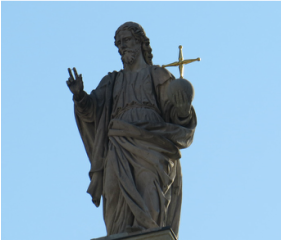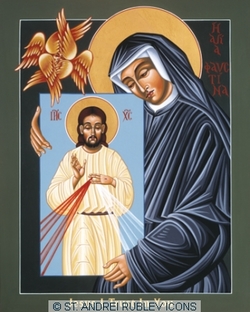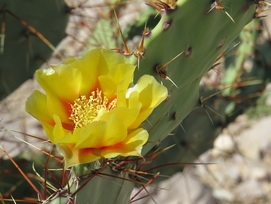 We are nearing the commencement of the Year of Mercy as announced by Pope Francis earlier this year. The Year of Mercy will begin on the Feast of the Immaculate Conception, December 8, 2015, and will conclude with the Feast of Christ the King, November 20, 2016. The Pope said a new term will be added to the title of Christ celebrated that day, calling Jesus "the living face of the mercy of the Father." * This is significant, but not new to the message of Pope Francis. Even if we have only been remotely paying attention to his ministry, it would be difficult to miss his overriding message of mercy and compassion professed through just about everything he says and does. Mercy was indeed the consistent message of Jesus during His life and ministry so we should not be surprised that this message is being highlighted at this time by this pope. Mercy is the gospel message and it is important for us to grow in this grace. On October 5 a feast day on the Church calendar should also direct our attention to the message of mercy. This day we celebrate St. Faustina, the saint whose entire life was devoted to the message of Divine Mercy. She was born Helena Kowalska in a small village near Lodz, Poland on August 25, 1905. She was from a poor peasant family who were very religious. She had experienced a call to religious life at the age of seven while praying before the Blessed Sacrament, but it took her until she was twenty years of age before she could finally enter religious life after having worked as a housekeeper to assist her parents financially. She entered the Sisters of Our Lady of Mercy and took the name of Sr. Maria Faustina of the Blessed Sacrament. Given the experience she had when she was young, it is not surprising that she had a great devotion to Jesus in the Blessed Sacrament, reflected in her choice of religious name.  Sr. Faustina’s life was filled with personal suffering, both physical and spiritual. She embraced the suffering because she felt that it was something she could offer for others. She worked hard in her life as a sister, so it almost defies the imagination how she could have written her extensive diary, Divine Mercy in My Soul. It runs about 650 (printed) pages all of which she wrote by hand in a series of notebooks at the request of Jesus. The contents of this diary are verbatim accounts of her encounters with Jesus and Mary during her prayer, written over the last four years of her life. She had many visions of Jesus; the most notable, of course, is the image of Jesus as Divine Mercy which she subsequently had painted based on her vision. This image eventually spread throughout the world. But she also left us some other important tools for how to live mercy: prayers, including the Chaplet of Divine Mercy, a prayer given her by Jesus and prayed on ordinary Rosary beads, the institution of Divine Mercy Sunday, (which was promulgated by another Polish saint, John Paul II), and her Diary which helps us to be inspired by her life. Though St. Faustina died of tuberculosis in 1938 at age 33, her short life was packed with revelation. Her Diary is very detailed, but the continuous message is that in Jesus is found an “ocean of mercy” into which He desires to immerse every one of us. In one of the visions Jesus said: “Write this: before I come as the just Judge, I am coming first as the King of Mercy.” (Diary, 83) As Pope Francis said, Jesus is the living face of the mercy of the Father. God wants us to have His mercy and nothing less. Therefore it is imperative that we understand this: Jesus desires to offer us mercy rather than judgment. And it is also important that we become people of mercy, offering the same mercy which we have received to those whom we encounter.  St. Faustina is remembered not only for her visions and the message contained in her Diary, but because she lived a life of kindness and mercy. She was not canonized because she had visions; having visions is not criteria for canonization. She was canonized because she lived what Jesus taught her. She desired to conform her will to His, reflecting the living face of God’s mercy. She wrote: “Neither graces, nor revelations, nor raptures, nor gifts granted to a soul make it perfect, but rather the intimate union of the soul with God. These gifts are merely ornaments of the soul, but constitute neither its essence nor its perfection. My sanctity and perfection consist in the close union of my will with the will of God.” (Diary, 1107) She never desired attention or any reward for her work in promoting mercy. She simply loved Jesus so much that she wanted His will to be done. In short, she wanted His mercy to be known because she was so filled with the gift of mercy Jesus gave to her. If we allow mercy to touch our souls deeply, as it did St. Faustina, we can then become disciples of mercy. I think this is what the Year of Mercy is really meant to be: that we would become truer disciples of Jesus, the King of Mercy, bringing His mercy into our prayer and into our actions. The gospels are truly annals of mercy. Everything Jesus did was about giving mercy to the poor, sick, marginalized, criminal, pagan, sinner, and alien. His mercy was extended to unbelievers, detractors, enemies, and those who put Him to death. His mercy was given to His friends who failed Him so overwhelmingly during His arrest and subsequent death. Every word of His teaching has to do with living love, especially through receiving and giving the gift of mercy and compassion to everyone we meet, especially our detractors. But the gospels are more than annals; they are a living message, containing truths about mercy and love. Having a year in which we dedicate our lives to working on the virtue of mercy could not be more important or timelier. We must become like Jesus, the One whom we follow: we must reflect the living face of the mercy of the Father.  Perhaps as we prepare for the Year of Mercy we can discern how we might fully participate. If we want to take on the rather lengthy book, (which I highly recommend as spiritual reading), we can make the commitment to read St. Faustina’s Diary: Divine Mercy in My Soul. I would suggest taking a little bit every day during the Year of Mercy, reading short entries and reflecting upon them. If that is too daunting a task, then maybe praying the Chaplet of Divine Mercy regularly (daily) would be a good way to pray for the virtue of mercy for oneself and for the whole world. Another suggestion is to read Matthew 25:31-46 and then making an effort to live the corporal works of mercy found within that passage. Perhaps making a conscious effort to do one of them each week (or whenever the opportunity presents itself) would be a fitting way to live the Year of Mercy. If we are intentional about trying to perform one of the works weekly, it will become habitual. But if none of these work for us, at the very least we can incorporate the image of Jesus and the short prayer “Jesus, I trust in You” into our daily life, asking the Lord to bring His mercy upon us and the whole world.  Living the mercy we are offered from Jesus is what St. Faustina aspired to do and it is not out of the realm of possibility that we can become as she did in our own way and in our own circumstances. St. Faustina had to overcome many obstacles and she suffered greatly, yet she was remembered by her sisters as being quite cheerful. But in her deep love for Jesus she was willing to make His mercy known no matter what the cost. Indeed, our world needs mercy desperately and that mercy is available. But if we do not live that mercy, the world will have no way of knowing about it or experiencing it. This is no easy task, but it is what Jesus desires. Let us follow in the footsteps of St. Faustina, doing all we can to bring mercy into everything we do. We can start by living the Year of Mercy, but we can also make mercy our lifelong commitment. Jesus desires that we receive His mercy, so let us immerse ourselves in the ocean of His mercy and invite others into the waters of mercy, too. In doing so, we can all come to know the face of the mercy of the Father. May we truly come to trust in the mercy of Jesus! May we be inspired by St. Faustina to become disciples of Divine Mercy, to live and share in the mercy of Jesus! May we live the Corporal Works of Mercy! May we learn that doing small works of mercy with great love can change the world! May we give ourselves to Jesus, accepting His mercy and sharing it with others! And may we embrace the Year of Mercy as a beginning of renewed love for Jesus, with gratitude for His gift of mercy to us and to the whole world! Let us continue to meet in the Merciful Heart of Jesus! Peace! ©Michele L. Catanese * Here is where the quote came from. The article was from when Pope Francis announced the Year of Mercy. http://ncronline.org/news/vatican/francis-announces-new-global-jubilee-holy-year-mercy Here are some links to more information on St. Faustina: http://www.americancatholic.org/Features/Saints/saint.aspx?id=1931 http://www.catholic.org/saints/saint.php?saint_id=510 https://en.wikipedia.org/wiki/Faustina_Kowalska All the photos are mine. The first was taken in Salzburg, Austria. Next is an icon painted by Fr. William Hart McNichols called St. Faustina Kowalska Apostle of Divine Mercy. It wonderfully brings together St. Faustina and the image she saw, so it is a great way to meditate upon Divine Mercy. If you are interested in purchasing a copy it can be found at http://fineartamerica.com/featured/st-faustina-kowalska-apostle-of-divine-mercy-094-william-hart-mcnichols.html Next are two of my photos: a cactus flower, taken at Big Bend National Park, TX. I chose it because the flower appears to be fragile, yet bold amidst the thorns of the cactus plant, just as mercy may appear fragile but is in fact bold. The second is of the Atlantic Ocean taken at Westhampton Beach, Long Island. I chose it to remind us of the oceans of mercy found in Jesus. Finally is the original image, as guided by St. Faustina, of Jesus as King of Divine Mercy . Comments are closed.
|
Heart Speaks to Heart
|

 RSS Feed
RSS Feed

